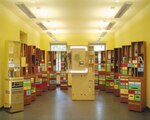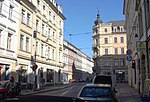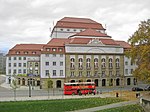Erich Kästner Museum

The Erich Kästner Museum is a literary museum in Dresden, Germany. The museum covers the life and writings of German children's author Erich Kästner and is based in the Villa Augustin building which had belonged to Kästner's uncle. The museum is notable for its architecture, which was designed to be semi-mobile and fit within a single room,: 28 close to where Kästner had grown up in Dresden's inner new town (Innere Neustadt). The museum focuses on Kästner's early years in Dresden and Leipzig, the connections between his work and children, and his relationship to the media. The museum collection includes first editions by Kästner, including his most famous work Emil and the Detectives, along with garments and objects belonging to Kästner.
Excerpt from the Wikipedia article Erich Kästner Museum (License: CC BY-SA 3.0, Authors, Images).Erich Kästner Museum
Antonstraße, Dresden Innere Neustadt (Neustadt)
Geographical coordinates (GPS) Address Nearby Places Show on map
Geographical coordinates (GPS)
| Latitude | Longitude |
|---|---|
| N 51.0638 ° | E 13.7457 ° |
Address
Villa Augustin
Antonstraße 1
01097 Dresden, Innere Neustadt (Neustadt)
Saxony, Germany
Open on Google Maps










